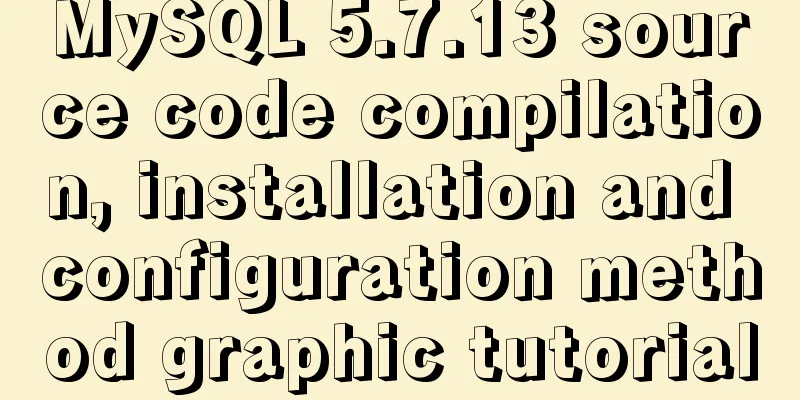MySQL 5.7.13 source code compilation, installation and configuration method graphic tutorial

|
Installation environment: CentOS7 64-bit MINI version Official source code compilation and installation document: http://dev.mysql.com/doc/refman/5.7/en/source-installation.html 1. System Installation Conditions Official documentation: http://dev.mysql.com/doc/refman/5.7/en/source-installation.html 1>cmake MySQL uses the cmake cross-platform tool to precompile source code, which is used to set the compilation parameters of MySQL. Such as: installation directory, data storage directory, character encoding, sorting rules, etc. Just install the latest version. 2> make3.75 The MySQL source code is written in C and C++. Use make to compile and build the source code under Linux. You must install make 3.75 or above. 3> gcc4.4.6 GCC is a C language compiler under Linux. MySQL source code compilation is completely written in C and C++. It is required to install GCC4.4.6 or above. 4> Boost1.59.0 The MySQL source code uses the C++ Boost library, which requires that you install boost 1.59.0 or later. 5> bison2.1 C/C++ parser for Linux 6> ncurses Character terminal processing library So before installation, you need to install the relevant dependent libraries: shell> sudo yum install -y cmake,make,gcc,gcc-c++,bison, ncurses,ncurses-devel Download the Boost 1.59.0 source code and unzip it to the /usr/local/ directory: shell> wget -O https://sourceforge.net/projects/boost/files/boost/1.59.0/boost_1_59_0.tar.gz shell> tar -zxvf boost_1_59_0.tar.gz -C /usr/local/ 2. Download MySQL source code Download the mysql source code from github shell> cd /opt shell> git clone https://github.com/mysql/mysql-server.git shell> ls mysql-server If the git client is not installed, run yum install -y git to install it.
shell> git branch -r origin/5.5 origin/5.6 origin/5.7 origin/HEAD -> origin/5.7 origin/cluster-7.2 origin/cluster-7.3 origin/cluster-7.4 origin/cluster-7.5 The current branch defaults to version 5.7. If you want to install other versions, just switch to the corresponding branch. For example, if you want to install version 5.6: git checkout 5.6. Here we take the installation of version 5.7 as an example. Sohu mirror download address: 3. Installation 1> Add mysql user shell> cd /opt/mysql-server shell> groupadd mysql #Add mysql user group shell> useradd -r -g mysql -s /bin/false mysql #Add mysql user 2> Configure mysql precompilation parameters shell> cmake . -DCMAKE_INSTALL_PREFIX=/usr/local/mysql \ -DMYSQL_DATADIR=/usr/local/mysql/data \ -DWITH_BOOST=/usr/local/boost_1_59_0 \ -DSYSCONFDIR=/etc \ -DEFAULT_CHARSET=utf8mb4 \ -DDEFAULT_COLLATION=utf8mb4_general_ci \ -DENABLED_LOCAL_INFILE=1 \ -DEXTRA_CHARSETS=all -DCMAKE_INSTALL_PREFIX: installation path For more precompiled configuration parameters, please refer to the official MySQL documentation: http://dev.mysql.com/doc/refman/5.7/en/source-configuration-options.html#cmake-general-options 3> Compile and install shell> make -j `grep processor /proc/cpuinfo | wc -l` shell> make install The -j parameter specifies the number of threads during compilation based on the number of CPU cores, which can speed up compilation. The default is 1 thread compilation. After testing, on a single-core CPU and 1G of memory, it takes nearly 1 hour to compile. 4> Initialize the system database shell> cd /usr/local/mysql shell> chown -R mysql:mysql . # Note: For versions prior to MySQL 5.7.6, execute this script to initialize the system database shell> ./bin/mysql_install_db --user=mysql --basedir=/usr/local/mysql --datadir=/usr/local/mysql/data # Initial system database script for versions after 5.7.6 (this article uses this method to initialize) shell> ./bin/mysqld --initialize-insecure --user=mysql --basedir=/usr/local/mysql --datadir=/usr/local/mysql/data shell> ./bin/mysql_ssl_rsa_setup shell> chown -R root . shell> chown -R mysql data Note: If you use the --initialize parameter to initialize the system database, a temporary password for the root user will be generated in the ~/.mysql_secret file and printed out in the initialization log, as shown in the red circle in the following figure:
5. Configuration file and parameter optimization shell> cp support-files/my-default.cnf /etc/my.cnf shell> vim /etc/my.cnf [client] port=3306 socket=/usr/local/mysql/mysql.sock [mysqld] character-set-server=utf8 collation-server=utf8_general_ci skip-external-locking skip-name-resolve user=mysql port=3306 basedir=/usr/local/mysql datadir=/usr/local/mysql/data tmpdir=/usr/local/mysql/temp # server_id = ..... socket=/usr/local/mysql/mysql.sock log-error=/usr/local/mysql/logs/mysql_error.log pid-file=/usr/local/mysql/mysql.pid open_files_limit=10240 back_log=600 max_connections=500 max_connect_errors=6000 wait_timeout=605800 #open_tables=600 #table_cache = 650 #opened_tables = 630 max_allowed_packet=32M sort_buffer_size=4M join_buffer_size=4M thread_cache_size=300 query_cache_type=1 query_cache_size=256M query_cache_limit=2M query_cache_min_res_unit=16k tmp_table_size=256M max_heap_table_size=256M key_buffer_size=256M read_buffer_size=1M read_rnd_buffer_size=16M bulk_insert_buffer_size=64M lower_case_table_names=1 default-storage-engine=INNODB innodb_buffer_pool_size=2G innodb_log_buffer_size=32M innodb_log_file_size=128M innodb_flush_method=O_DIRECT ##################### thread_concurrency=32 long_query_time=2 slow-query-log=on slow-query-log-file=/usr/local/mysql/logs/mysql-slow.log [mysqldump] quick max_allowed_packet=32M [mysqld_safe] log-error=/var/log/mysqld.log pid-file=/var/run/mysqld/mysqld.pid 6. Configure MySQL service shell> cp support-files/mysql.server /etc/init.d/mysqld shell> chkconfig --add mysqld # Add to system services shell> chkconfig mysqld on # Start at boot 7. Start the service shell> service mysqld start # Start MySQL service shell> service mysqld stop # Stop MySQL service shell> service mysqld restart # Restart MySQL service 8. Set the database password shell> /usr/local/mysql/bin/mysql -e "grant all privileges on *.* to root@'127.0.0.1' identified by "root" with grant option;" shell> /usr/local/mysql/bin/mysql -e "grant all privileges on *.* to root@'localhost' identified by "root" with grant option;" # Enable remote login (set host to %) /usr/local/mysql/bin/mysql -e "grant all privileges on *.* to root@'%' identified by "root" with grant option;" 9. Configure MySQL environment variables shell> vim /etc/profile shell> export PATH=/usr/local/mysql/bin:$PATH shell> source /etc/profile 4. Other matters needing attention If the compilation fails midway, you need to delete the cache file of the pre-compilation configuration parameters generated by cmake and the file generated after make compilation, and then recompile. shell> cd /opt/mysql-server shell> rm -f CMakeCache.txt shell> make clean The above is the full content of this article. I hope it will be helpful for everyone’s study. I also hope that everyone will support 123WORDPRESS.COM. You may also be interested in:
|
<<: Example of using Dockerfile to build an nginx image
>>: jQuery realizes the shuttle box effect
Recommend
Docker container monitoring and log management implementation process analysis
When the scale of Docker deployment becomes large...
Detailed explanation of two points to note in vue3: setup
Table of contents In vue2 In vue3 Notes on setup ...
The difference between KEY, PRIMARY KEY, UNIQUE KEY, and INDEX in MySQL
The problem raised in the title can be broken dow...
Detailed explanation of CSS to achieve the effect of illuminating the border by imitating the Windows 10 mouse
After installing the latest Windows 10 update, I ...
Implementation of Linux command line wildcards and escape characters
If we want to perform batch operations on a type ...
Detailed explanation of how to use JavaScript paging component
The pagination component is a common component in...
Experience sharing by a front-end supervisor with 7 years of practical experience
Today, I am sharing the valuable experience of a ...
How to install mysql8.0.23 under win10 and solve the problem of "the service does not respond to the control function"
Install mysql under win10 1. Download MySQL from ...
Detailed explanation of mixed inheritance in Vue
Table of contents The effect of mixed inheritance...
Several methods to clear floating (recommended)
1. Add an empty element of the same type, and the...
One-click installation of MySQL 5.7 and password policy modification method
1. One-click installation of Mysql script [root@u...
Detailed tutorial on OpenStack environment deployment based on CentOS (OpenStack installation)
Effect display: Environment preparation controlle...
Detailed explanation of how to install the system on VMware workstation 14 pro (virtual machine)
This article introduces how to install the system...
Markup Languages - Lists Again
Click here to return to the 123WORDPRESS.COM HTML ...
Learn javascript iterator
Table of contents Introduction What does an itera...











